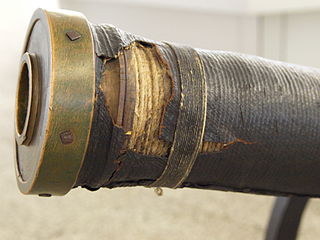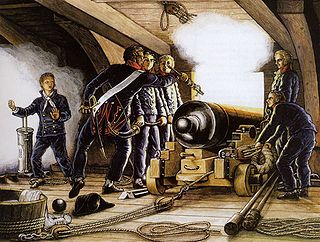
Artillery is a class of heavy military weapons built to fire munitions far beyond the range and power of infantry's small arms. Early artillery development focused on the ability to breach defensive walls, and fortifications, and led to heavy, fairly immobile siege engines. As technology improved, lighter, more mobile field artillery developed for battlefield use. This development continues today; modern self-propelled artillery vehicles are highly mobile weapons of great versatility providing the largest share of an army's total firepower.
Infantry support guns or battalion guns are artillery weapons designed and used to increase firepower of infantry units they are intrinsic to; offering immediate tactical response to the needs of the unit's commanding officer. The designs are typically with short low velocity barrels, and light construction carriages allowing them to be more easily manoeuvred on the battlefield. They are generally used for direct fire missions, as opposed to indirect fire like other artillery units. Their role has generally been replaced by tanks, other support vehicles or mortars, recoilless rifles and rocket-propelled grenades.

Naval artillery is artillery mounted on a warship, originally used only for naval warfare, later also for shore bombardment and for anti-aircraft use. The term generally refers to tube-launched projectile-firing weapons and excludes self-propelled projectiles like torpedoes, rockets, and missiles and those simply dropped overboard like depth charges and naval mines.

Caroleans were soldiers of the Swedish kings Charles XI and Charles XII. Their tactics differed from those of Western Europe through a greater reliance upon pikes, rapiers, bayonets, and offensive strategy. These differences led them to victory in many battles, even when greatly outnumbered. In order to compensate for its lack of manpower and resources, Sweden strove for innovative ways to make a more effective army. Thanks to their achievements during the Great Northern War, the Carolean army is regarded to have been the most effective military force of their day, as shown by their efforts in battles such as Narva, Düna, Klissow, Pultusk, Jakobstadt, Gemauerthof, Warsaw, Fraustadt, Holowczyn, Helsingborg, and Gadebusch.

Field artillery is a category of mobile artillery used to support armies in the field. These weapons are specialized for mobility, tactical proficiency, short range, long range, and extremely long range target engagement.

Field artillery in the American Civil War refers to the artillery weapons, equipment, and practices used by the Artillery branch to support the infantry and cavalry forces in the field. It does not include siege artillery, use of artillery in fixed fortifications, or coastal or naval artillery. Nor does it include smaller, specialized artillery classified as small arms.

Horse artillery was a type of light, fast-moving, and fast-firing artillery which provided highly mobile fire support, especially to cavalry units. Horse artillery units existed in armies in Europe, the Americas, and some Asian countries, from the 17th to the early 20th century. A precursor of modern self-propelled artillery, it consisted of light cannons or howitzers attached to light but sturdy two-wheeled carriages called caissons or limbers, with the individual crewmen riding on horses. This was in contrast to the rest of the field artillery, which were also horse-drawn but whose gunners were normally transported seated on the gun carriage, wagons or limbers.

The leather cannon, or leather gun, was an experimental weapon, first used in northern Europe in the 1620s. The aim was to construct a light and cheap weapon that would bridge the gap between the handy musket and the heavy stationary cannon. The varnished leather from which the gun got its name acted merely as the outer protective surface of the piece.

The first usage of cannon in Great Britain was possibly in 1327, when they were used in battle by the English against the Scots. Under the Tudors, the first forts featuring cannon batteries were built, while cannon were first used by the Tudor navy. Cannon were later used during the English Civil War for both siegework and extensively on the battlefield.

Cannon operation required specialised crew and gunners, who were first enlisted by the Spanish in the 14th century. The nature of cannon operation often depended on the size of the cannon and whether they were breech-loading or muzzle-loading. English cannon of the late 14th century became mobile, while the largest cannon required huge crews to transport and operate them.

Licorne is the French name of an 18th- and 19th-century Russian cannon, a type of muzzle-loading howitzer, devised in 1757 by M.W. Danilov and S.A. Martynov and accepted by artillery commander, general Peter Ivanovich Shuvalov.

The twelve-pound cannon is a cannon that fires twelve-pound projectiles from its barrel, as well as grapeshot, chainshot, shrapnel, and later shells and canister shot. It was first used during the Tudor period and was commonly used during the Napoleonic Wars, 1799-1815. At this time 12 lbers were the largest caliber of long-barreled field pieces, and were used both at long range against fortifications and troop concentrations using round shot and against attacking infantry and cavalry using canister shot. As such the 12 lber was a favorite weapon of the Grande Armée. Later, redesigned 12 lbs were named after Napoleon III and found heavy use during the American Civil War.

In historical naval usage, a long gun was the standard type of cannon mounted by a sailing vessel, so called to distinguish it from the much shorter carronades. The long gun was known for its increased range and improved mobility in comparison to its larger precursors. This allowed the long gun to establish itself as the best form of artillery to pursue an enemy.

The Gribeauval system was an artillery system introduced by Lieutenant General Jean Baptiste Vaquette de Gribeauval during the 18th century. This system revolutionized French cannons, with a new production system that allowed lighter, more uniform guns without sacrificing range. The Gribeauval system superseded the Vallière system beginning in 1765. The new guns contributed to French military victories during the French Revolutionary Wars and Napoleonic Wars. The system included improvements to cannons, howitzers, and mortars. The Year XI system partly replaced the field guns in 1803 and the Valée system completely superseded the Gribeauval system in 1829.

The Canon de 12 Gribeauval or 12-pounder was a French cannon and part of the system developed by Jean Baptiste Vaquette de Gribeauval. There were 1.079 English pounds in the Old French pound, making the weight of shot nearly 13 English pounds. The 12-pounder was the heaviest cannon in the French field artillery; the others were the light Canon de 4 Gribeauval and the medium Canon de 8 Gribeauval. Superseding the previous Vallière system, the Gribeauval system was adopted in 1765 and its guns were first used during the American Revolutionary War. The greatest use of Gribeauval guns came during the French Revolutionary Wars and the Napoleonic Wars. During the latter wars, the 12-pounder was often employed in corps artillery reserves. Because of their physical and psychological effect, Emperor Napoleon increased the number of 12-pounders in his artillery and fondly called the cannons his belles filles. Gribeauval cannons fired canister shot for close-range work and round shot at more distant targets. In 1803 the Year XI system was introduced, but it only partly replaced the Gribeauval system which was not completely replaced until the Valée system was set up in 1829.

The Canon de 8 Gribeauval or 8-pounder was a French cannon and part of the Gribeauval system developed by Jean Baptiste Vaquette de Gribeauval. The Old French pound was 1.07916 English pounds, making the weight of shot about 8.633 English pounds. The 8-pounder was the medium weight cannon of the French field artillery; the others were the light Canon de 4 Gribeauval and the heavy Canon de 12 Gribeauval. Replacing the older Vallière system, the Gribeauval system was introduced in 1765 and the guns were first employed during the American Revolutionary War. The most extensive use of Gribeauval guns was during the French Revolutionary Wars and the Napoleonic Wars. The 8-pounder could be found in divisional reserves, advanced guards or army artillery reserves. Emperor Napoleon began to phase out the 8-pounder by increasing the proportion of 12-pounders in his artillery. The emperor began switching calibers to the handier 6-pounder piece, utilizing captured guns as well as newly designed French cannons. The Year XI system began in 1803, but it only partly replaced the Gribeauval system which was not entirely suppressed until the Valée system was introduced in 1829.

The Obusier de 6 pouces Gribeauval or 6-inch howitzer was a French artillery piece and part of a system established by Jean Baptiste Vaquette de Gribeauval. The Old French inch was actually 1.066 English inches long so the weapon can accurately be described as a 6.4-inch howitzer. The Gribeauval system included the 6-inch howitzer, the light Canon de 4 Gribeauval, medium Canon de 8 Gribeauval and the heavy Canon de 12 Gribeauval. Superseding the older Vallière system, the Gribeauval system was introduced in 1765 and the guns were first used during the American Revolutionary War. The most comprehensive employment of Gribeauval guns occurred during the French Revolutionary Wars and the Napoleonic Wars. Two 6-inch howitzers were often added to four or six cannons to make up a battery of artillery in Napoleon's armies. The 6-inch howitzer was capable of firing an exploding shell at long-range targets or a canister shot at close-range enemy personnel. Starting in 1803, the Year XI system partly replaced the Gribeauval artillery, but it was not until 1829 that the Gribeauval system was wholly superseded by the Valée system.

The de Bange 155 mm long cannon mle. 1877 was the French artillery piece that debuted the 155 mm caliber in widespread use today. Although obsolete by the beginning of World War I, the 155 L was nonetheless pressed into service and became the main counter-battery piece of the French army in the first two years of the war.

The Canon de 4 Gribeauval or 4-pounder was a French cannon and part of the artillery system developed by Jean Baptiste Vaquette de Gribeauval. The Old French pound was 1.079 English pounds, making the weight of shot about 4.3 English pounds. In the Gribeauval era, the 4-pounder was the lightest weight cannon of the French field artillery; the others were the medium Canon de 8 Gribeauval and the heavy Canon de 12 Gribeauval. The Gribeauval system was introduced in 1765 and the guns were first employed during the American Revolutionary War. The most large-scale use of Gribeauval guns occurred during the French Revolutionary Wars and the Napoleonic Wars. At first a pair of 4-pounders were assigned to each infantry battalion and were often called battalion pieces. Later, Emperor Napoleon took the guns away from the infantry units and began to replace the 4-pounder with the 6-pounder, using captured guns as well as newly cast French cannons. However, as the French infantry declined in quality after 1809, the 4-pounders were reintroduced in order to provide direct support for formations of foot soldiers. All Gribeauval cannons were capable of firing canister shot at close-range and round shot at long-range targets. The Gribeauval system supplanted the older Vallière system, was partly replaced by the Year XI system in 1803 and completely superseded by the Valée system in 1829.















